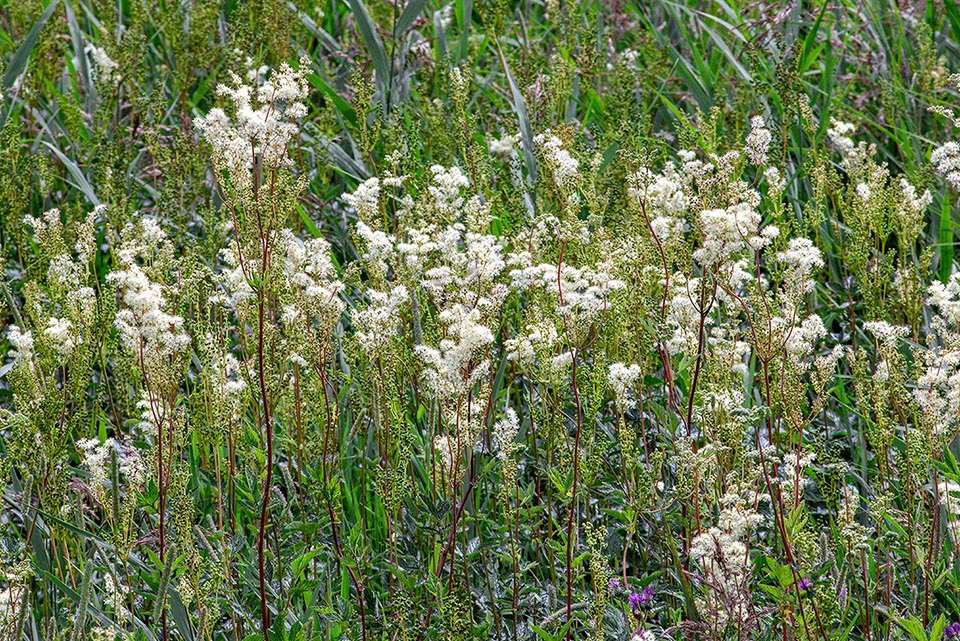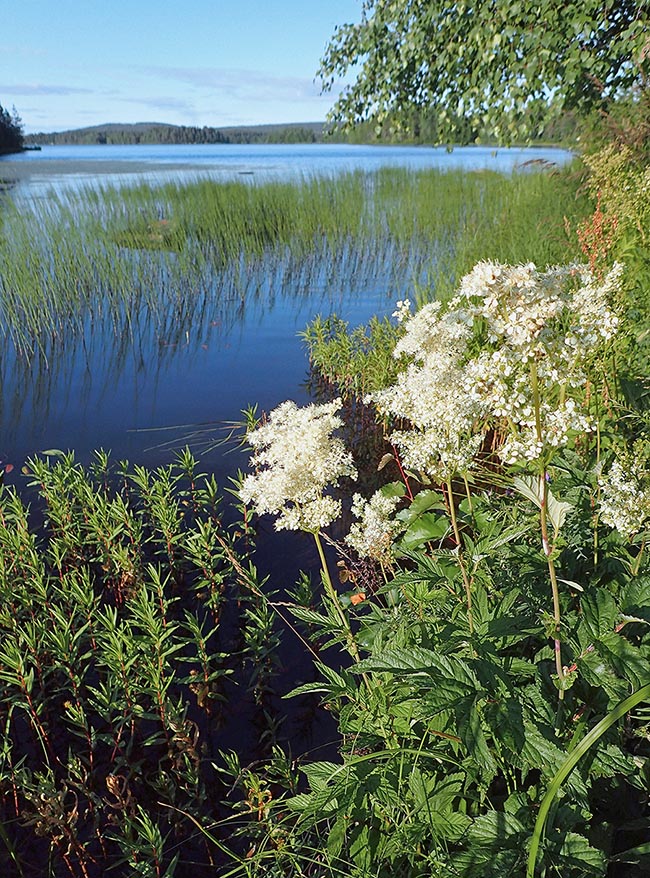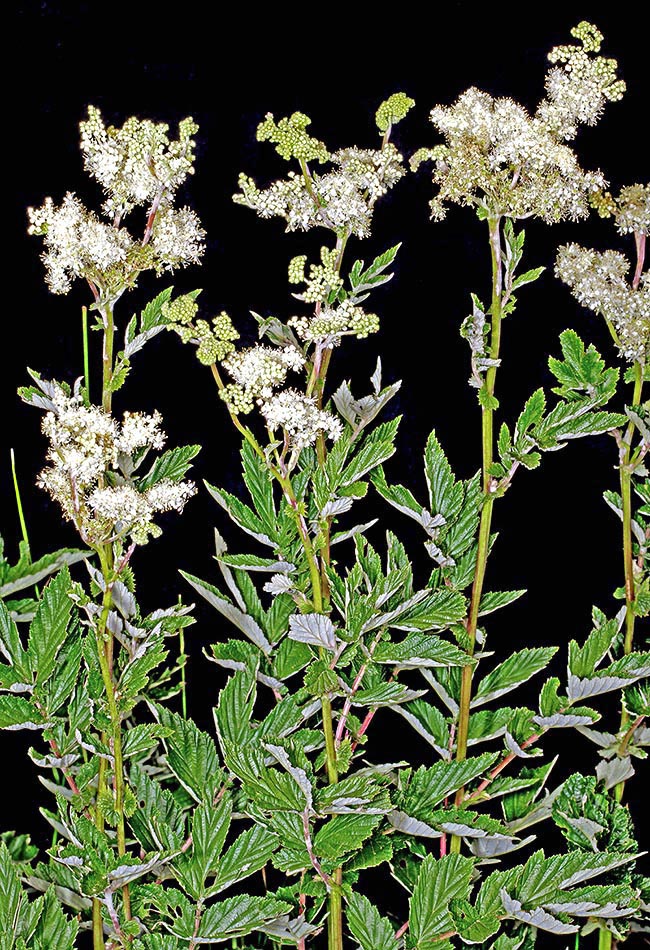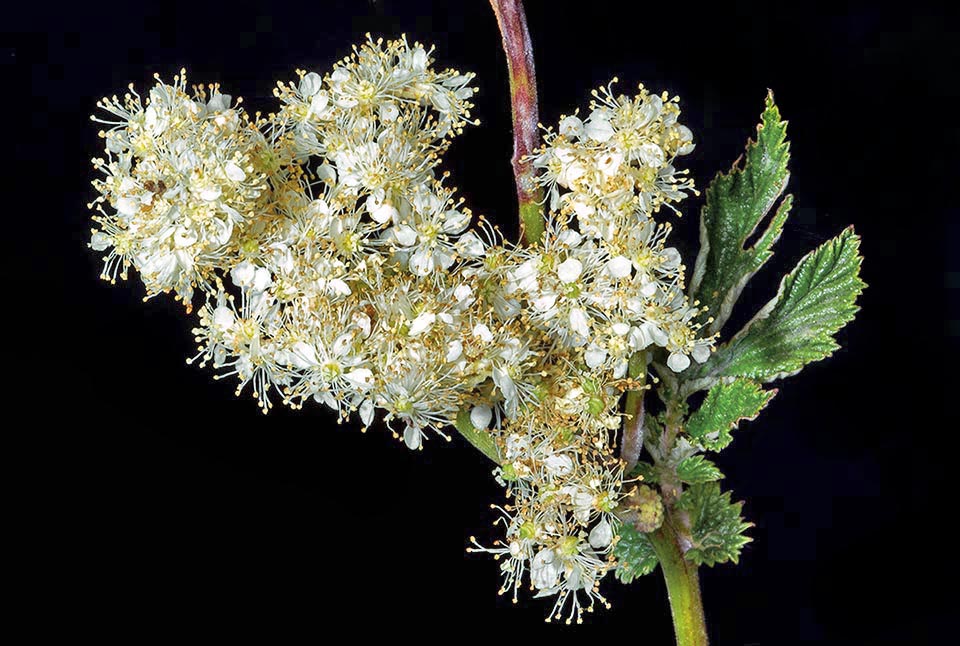Family : Rosaceae

Text © Prof.sa Franca Bessi

English translation by Mario Beltramini

The Filipendula ulmaria dominates the other herbaceous plants of the damp meadows with rich perfumed inflorescences up to 1600 m of altitude © Giuseppe Mazza
Filipendula ulmaria (L.) Maxim. belongs to the family Rosaceae, subfamily Rosoideae, tribe Ulmarieae.
Linnaeus classified this species with the name Spiraea ulmaria in Sp. Pl.: 490 (1753) but, later on, the Russian botanist Carl Johann (Ivanovič) Maximowicz (1827-1891) modified the generic epithet from Spiraea in Filipendula and described it validly in Trudy Imp. S.-Peterburgsk. Bot. Sada 6(1): 251 (1879).
The primitive denomination of the genus, due to the mutual vortex position of the achenes, had taken its name from spiral, in Greek σπείρα, whilst the second derives it from the composition of the Latin terms filum (thread) and pendĕo (to be hanged) as in the root system, several tuberiform swellings are stuck to more or less filiform roots. Conversely, the constant scientific denomination originates from the appearance of the leaflets that recall that of the leaves of the elm (from the Latin ulmarius = of the elm, related to the elm Ulmus sp. pl.).
To the genus Filipendula are ascribed more than ten species, seven for China alone; in Europe we find Filipendula ulmaria (L.) Maxim. and Filipendula vulgaris Moench, both with white flowers borne in multiple inflorescences.

The very vast range goes from Europe to the extreme East and from South Russia to Iran © Jean Louis Verbruggen
These two species display appreciable differences between them in the conformation of the pinnate leaves where the segments with more expanded lamina are spaced by others smaller, the first has a number of foliar segments smaller (5-9) though ampler, the second has a bigger number (20-many) of them but of smaller; the two species differ also in the size of the flowers, in fact the petals of Filipendula vulgaris are almost twice (5-9)mm as long than those (2-5) mm of Filipendula ulmaria.
Filipendula ulmaria includes the taxa: Filipendula ulmaria subsp. ulmaria and Filipendula ulmaria subsp. picbaueri (Podp.) Smejkal, or steppe filipendula, that has the terminal segment of the leaf pentalobate.
The distribution range of Filipendula ulmaria goes from Europe to the Far East and from southern Russia to Iran.
Its habitat is that of the hygrophilous or marshy grasslands, of the banks of small streams, of riparian or hygrophilous woods, from the sea level up to the mountain vegetation plan.
The common name of ‘queen of the meadow’, met in several languages, identifies the relevance ( it’s considered an alliance guide species) that this plant assumes in the natural contexts in which it grows, also due to its visual impact; the most usual nicknames of this species are: Olmaria, Barba di Capra, Regina dei Prati (Italian), Meadowsweet, Queen-of-the-meadow (English), Spirée ulmaire, Reine-des-prés (French), Ulmaria, Reina de los Prados (Spanish), and Mädesüss, Echtes Mädesüss (German).
Filipendula ulmaria is an erect perennial plant, with the aerial herbaceous part that dries up (scapose hemicryptophyte) whose rigid floral stems reach a height of 130 (200) cm; the stems are of greenish brown or reddish colour and the imparipinnate leaves are intensely green above whilst, below, they may appear tomentose or glabrous with hairy veins.
The leaves have toothed amplexicaul stipules with a semi-circular contour and present the big leaflets opposite in pairs and the tiny leaflets usually alternate and spaced among the large ones; their terminal palmatafid segment is usually pentalobed or trilobed and the lobes have the size of the major segment. The leaflets are oval or lanceolate with big teeth doubly serrated in turn. In the basal leaves the pairs of the segments are 5 to 9. The leaves, more expanded in the basal part (up to 40 cm long), get smaller and also less pinnate upwards and at the end, before the inflorescence, may reduce to the only terminal leaflet.
The flowers are hermaphroditic and are borne by a thyrsoid inflorescence (anthela) where the primary axis and the upper peduncles, normally, are surpassed in height by the lower ones; the pedicels are hairy. The flowers are small, white or yellowish white and have the stamens longer than the petals; these, usually in number of 5, are separated from each other (dialypetalous) and have the shape of a long nail (oval or obovate, finely unguiculate) and 3-5 mm long; the sepals (normally 5), once the anthesis has occurred, are reflexed. The ovary is semi-inferior and the carpels (5-10) are bare and will ripen in apparently united follicles because they are twisted in a spiral.

Near the inflorescences the leaves are smaller with less segments. The lower side, tomentose, is whitish © G. Mazza
Blooming takes place in summer. The plant is intensely scented as such in the flowers (inebriating, sweet and honeyed smell) and somewhat austere in the leaves. The different morphology of the lower surface of the leaves (absence or presence of tomentum) led the botanists to distinguish Filipendula ulmaria var. denudata
(J.Presl & C.Presl) Maxim. from Filipendula ulmaria var. tomentosa (Cambess.) Maxim., both given in synonymy in IPNI with Filipendula ulmaria subsp. ulmaria (2n=14).
The horticultural variety Filipendula ulmaria ‘Flore pleno’ can be found on the market, a perennial plant with the inflorescences made even more showy by the white and double flowers. This cultivar, suitable for informal gardens also for the tuft of the basal leaves, is to be cleaned from the dry branches by the end of the blooming and must be watered regularly if planted in a pot. It flowers from mid-June up to mid-August and propagates in spring by seed as well as by division.
Filipendula ulmaria grows in humid, fertile, rich in humus soils, in full sun or shade and the IUCN (International Union for Conservation of Nature) does not mark it as an endangered species. It has been introduced by the settlers in some states of North America and in the Canadian provinces.
Due to its ornamental characteristics «Rich cymes of fragrant meadow – sweet ‘wave their creamy clusters,’ neath every passing breeze [the rich cymes of the perfumed filipendula wave with their cream coloured inflorescences under every breeze passing by] Leigh Page, Stars of Earth; Or Wild Flowers of the Months, 1868]» is used in the gardens decoration especially as border plant for marking the limits of ponds and streams.
To the intrinsic beauty of flowering we have to add the fact that few flowers are simultaneously so graceful and with a scent so intense to be at times almost stunning, this last characteristic appreciated in the centuries to be highlighted in poetry: «Rich cymes of fragrant Meadowsweet:/ Alas! those creamy clusters lend/ A charm, where death and odour meet! [the rich cymes of the perfumed filipendula: alas! Those cream inflorescences offer an enchantment where aroma and death meet!] Calder Campbell, A Brook and its Flowers, in The Ladie’s Companion, and Monthly Magazine, vol. III, 1853». The Victorian excesses of Campbell concerning the perfume of the filipendula, however, were not a common feeling; John Gerard in The Herball, Or Generall Historie of Plantes (1633) with his naturalist’s rigour had already reminded that the Regina prati, because of leaves and flowers, excelled over other herbs for the look as well as for decorating houses. A plant suitable, during the summer period, to be laid on the floors of the rooms, of the corridors and of the banqueting rooms rightly because the perfume of the meadowsweet cheered the heart, delighted the senses and did not cause, like other herbs having a sweet scent, headache or disgust for food.
Moreover, they hand down that queen Elizabeth I preferred it for this function among all mowing plants. The flowers can be used in the home made potpourris together with, for instance, rose and cornflower petals, lavender spikes, thymus inflorescences and marjoram and leaves of mint. The tradition gives us a magical plant, useful for unveiling potions and love filters and that with its scent dissolves tensions and rebalances the spirits; in the language of flowers is the emblem of vanity and of frivolity. The filipendula at times is mistaken, by inexperienced eyes, with Aruncus dioicus (Walter) Fernald because has, it too, showy inflorescences of white flowers at the top of long stems but that well differs from the meadowsweet due to the morphology of the leaves that are three-pinnately compound.

Filipendula ulmaria flowers are hermaphroditic, have semi-inferior ovary and are radially symmetrical with the stamens longer than the petals © Giuseppe Mazza
In the indigenous zones the meadowsweet is a plant of the popular medicine, held sacred by the Druids and indicated as the ‘silver rush’ by the Irish, is still now utilized as officinal and food (additive) plant; as flavouring plant, for the the sweet notes of almond of its flowers, has been employed by the brewers and it is thought since the very old times by the mead makers. The Filipendula ulmaria is still now employed in phytotherapy; in the herbalist’s shops can be found mainly in preparations of flower tops chopped for infusions/herbal teas (the infusion for internal as well as for external use must be prepared with warm water, but not boiling, in order not to inactivate its thermolabile principles), in capsules, in syrups (association with other simples) and in titrated extracts. The meadowsweet is traditionally used with anti-inflammatory function in supportive treatment of the common cold and of the articular pains, and is not recommended in general, in addition to those who are hypersensitive to salicylates and the active components of the preparations, to pregnant and breastfeeding women.
Filipendula ulmaria is an alternative source to Salix alba L. for obtaining the salicylic acid that has antiseptic properties that presently is obtained by synthesis like its acetylated derivative commercially known as aspirin. The salicylic acid is involved in the development of the systemic acquired resistance (SAR) activated by the plants after pathogen attack; during the SAR processes is often released in the air the methyl salicylate that can ‘inform’ the nearby plants of the presence of the pathogen(s).
Filipendula ulmaria has five synonyms recognized by POWO (Plants of the World Online): Spiraea ulmaria L., Spiraea ulmaria f. tomentosa (Hayne) St.-Lag. (not validly publ.), Spiraea ulmaria var. tomentosa Hayne, Thecanisia ulmaria (L.) Raf. ex B.D.Jacks. (comb. not validly publ.) and Ulmaria ulmaria (L.) Barnhart (not validly publ.).
→ To appreciate the biodiversity within ROSACEAE family please click here.
